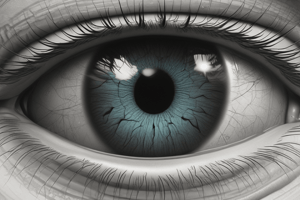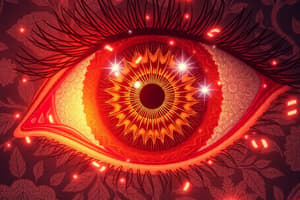Podcast
Questions and Answers
What type of lens is the human eye categorized as?
What type of lens is the human eye categorized as?
- Converging Lens (Convex) (correct)
- Diverging Lens (Concave)
- Flat Lens
- Aspheric Lens
A concave lens focuses light rays toward a focal point.
A concave lens focuses light rays toward a focal point.
False (B)
What is the function of the cornea in the human eye?
What is the function of the cornea in the human eye?
It acts as the outer surface where light enters.
The _____ regulates the size of the pupil and controls the amount of light entering the eye.
The _____ regulates the size of the pupil and controls the amount of light entering the eye.
Match the part of the eye with its function:
Match the part of the eye with its function:
What happens to light rays as they pass through a convex lens?
What happens to light rays as they pass through a convex lens?
The pupil is a transparent part of the eye that allows light to pass through.
The pupil is a transparent part of the eye that allows light to pass through.
Describe the journey of light as it enters the eye.
Describe the journey of light as it enters the eye.
Flashcards
What is a lens?
What is a lens?
A curved, transparent material that bends light in a predictable way.
Converging Lens (Convex)
Converging Lens (Convex)
A lens that bends light rays towards a central point.
Diverging Lens (Concave)
Diverging Lens (Concave)
A lens that bends light rays away from a central point. It makes images appear smaller.
Cornea
Cornea
Signup and view all the flashcards
Pupil
Pupil
Signup and view all the flashcards
Iris
Iris
Signup and view all the flashcards
Retina
Retina
Signup and view all the flashcards
Ciliary muscles
Ciliary muscles
Signup and view all the flashcards
Study Notes
How the Human Eye Perceives Light
- The human eye functions like a converging lens, also known as a convex lens
- A lens is a curved, transparent material that refracts light in a predictable way
- Mirrors reflect light, while lenses refract it
Types of Lenses
- Converging (Convex) Lens: Parallel light rays passing through converge at a focal point
- Diverging (Concave) Lens: Parallel light rays passing through spread apart, never meeting
How the Eye Processes Light
- Light enters the eye through the cornea, then passes through the pupil
- The iris controls the size of the pupil, regulating the amount of light entering
- The light then passes through the lens, which refracts the light again
- The image is projected onto the retina, which acts as a projection screen
- The brain inverts the image on the retina, making it right-side up
Parts of the Eye and their Functions
- Cornea: Outer surface of the eye, thin like a credit card, allowing light to enter, and heals if scratched
- Pupil: Dark, circular opening that allows light to pass through
- Iris: Coloured part of the eye, a circular band of muscle that controls the size of the pupil, regulating the amount of light that enters
- Lens: Refracts light again after passing through the pupil, Focuses light onto the retina, Its shape changes to focus on near/far objects
- Retina: Lining at the back of the eye acting as a projection screen for incoming light rays; the brain inverts the image, creating a right-side-up view
- Ciliary Muscles: Adjust the shape of the lens to focus on near and far objects
- Optic Nerve: Carries the electrical impulses from the retina to the brain, where the image is processed
Vision Correction
- Farsightedness (Hyperopia): Distant objects are clear, but close-up objects are blurry; a converging lens corrects this
- Nearsightedness (Myopia): Close objects are clear, but distant objects are blurry; a diverging lens corrects this
Studying That Suits You
Use AI to generate personalized quizzes and flashcards to suit your learning preferences.




